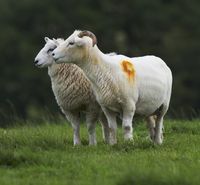Exmoor Mules help bring fresh hope to hill farmers

West Country hill farmers are staking their claim in the breeding ewe market and it’s creating an upturn in demand for a new look Exmoor Mule.
Bigger-framed and with a reputation for producing a good crop of lambs as hoggs, Exmoor Mule breeders say many lowland producers are switching back to Mules bred in their own region.
And according Somerset farmer Alan Collins it’s a trend which will help maintain the viability of many hill farms that have remained loyal to the breed.
 “It’s a case of local ewes for local people. The Exmoor Horn is the ideal ewe for West Country hill farms and we’re now seeing more lowland producers in the region recognise the qualities of the Exmoor Mule,” says Mr Collins who runs 1300 ewes – mainly Exmoor Horns – at Worth Farm, Withypool, Minehead.
“It’s a case of local ewes for local people. The Exmoor Horn is the ideal ewe for West Country hill farms and we’re now seeing more lowland producers in the region recognise the qualities of the Exmoor Mule,” says Mr Collins who runs 1300 ewes – mainly Exmoor Horns – at Worth Farm, Withypool, Minehead.
An West Country farmers needing to produce a prime lamb crop from farms that are “half way up the hill” are among the new band of Exmoor Mule supporters who say these ewes’ are showing hardiness and longevity.
Pressure on hill farm incomes in the south west – and competition from more mainstream Mule ewes – has fired the determination to lift demand for the Exmoor Mule. But breeders know they had to improve conformation to compete and produce gimmer lambs which would lamb easily as hoggs and still grow-on as shearlings, says Mr Collins.
“All sheep systems are under pressure and we were aware more gimmer lamb buyers want a fast return on their investment in the first year. But there’s also a trend among lowland producers who want to cut replacement costs and get back to basics with sheep suited to their local environment and have the breeding benefits of a first cross instead of a multi-cross breeding female,” says Mr Collins.
His 344ha (850 acre) LFA unit, running to 1250ft, also carries a flock of 30 Bluefaced Leicester ewes to breed rams to use on
| Exmoor mules |
|---|
|
“These aren’t small, skinny hill sheep. The Exmoor Horn has improved a lot in recent years and these improvements are now being passed on to the Exmoor Mule that’s lambing at well over 180%,” says Mr Collins.
He’s been producing Exmoor Mules for 15 years and last autumn his best gimmer lambs, sold at the traditional sales held at Blackmoor Gate, averaged £52 with his usual run of two-tooths averaging £73.
“Hill farms still have a vital role to play in the supply of commercial breeding ewes to the lowlands. The Bluefaced Leicester has made its mark in the north of England and can now help lift income on south west hill farms that have previously relied on producing store stock.
“As demand for Exmoor Mules develops we’ve got to ensure we continue using good tups on our hill ewes to maintain conformation, milkiness and prolificacy in the Mule ewe lambs and combine that with the Exmoor Horn’s hard wearing trait.
“I believe the growing demand from regional prime lamb producers for a ewe bred in their own neck of the woods will increase – the challenge will be to deliver the goods,” says Mr Collins who finishes 95% of his Exmoor Mule wether lambs by November off grass.
Producing a prime lamb crop instead of store lambs from “harder and wetter” land is providing essential income for West Country farms that don’t have the advantages of true, lowland grazings.
Bryan Smyth, who farms at Clifton, Barnstaple, has land running to 750ft and switched to Exmoor Mules five years ago. He says the breed wears better than any other commercial ewe he’s tried – and that’s helping to cut ewe replacement costs.
“We’re lambing them as shearlings and getting five or six crops out of them. Last year they cost about £40 apiece. I haven’t found anything to better the Exmoor Mule for this type of land where we a ewe needs to work hard to produce prime lambs from June onwards,” says Mr Smyth who runs 300 head in his 600-ewe flock on land running to 700ft.
